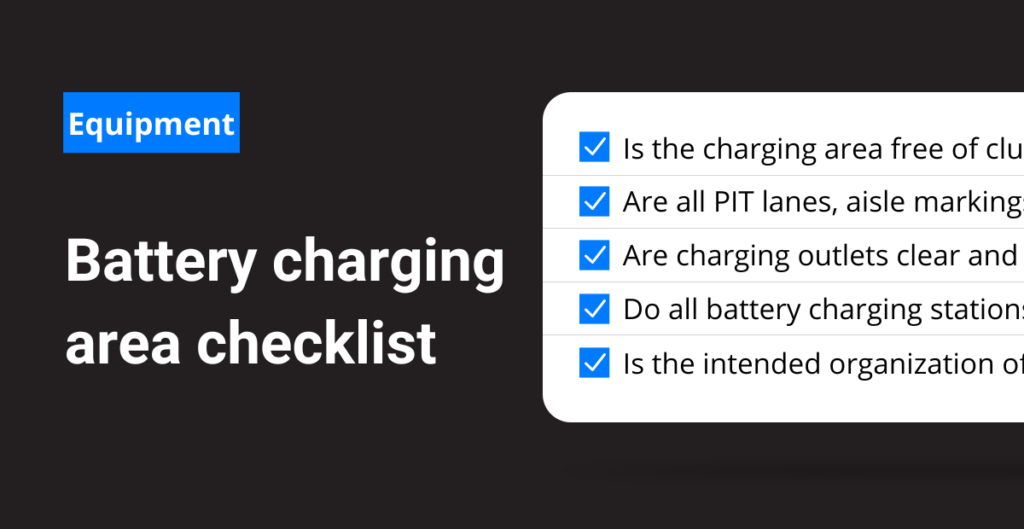Battery safety FAQs
What hazards are associated with industrial batteries?
- Hydrogen gas.
- Sulfuric acid.
- Shock.
- The weight of the battery
These dangers can be greater when batteries are:
- Being recharged
- Mismatched
- Connected incorrectly
- Damaged
- Overcharged
- Incorrectly handled or stored
Free checklist!
Use this simple checklist to inspect the safety of your battery charging area.

How can you reduce the risk of exploding batteries?
The charging of lead-acid batteries can be hazardous. When batteries are being recharged, they generate hydrogen gas that is explosive in certain concentrations in the air. The spark-retarding vents help slow the rate of release of hydrogen, but the escaping hydrogen may form an explosive atmosphere around the battery if ventilation is poor.
The ventilation system should be designed to provide an adequate amount of fresh air for the number of batteries being charged. This is essential to prevent an explosion.
In addition, use the following precautions.
- Always keep sparks, flames, burning cigarettes, and other sources of ignition away from the battery recharging area.
- Keep tools and other metallic objects away from uncovered batteries.
- Do not smoke in battery charging areas
- Wear protective eyewear when working near batteries.
- Do not break “live” circuits at the terminals of batteries.
- Have an ABC dry chemical fire extinguisher in charging areas.
How to prevent shock when handling batteries?
- Never touch both battery terminals with your bare hands at the same time.
- Remove rings, watches, and dangling jewelry when working with batteries.
- Only use insulated/non-conducting tools to remove cell caps.
- Never lay tools or other metal parts on top of a battery.
What safety precautions should you take if you are changing batteries?
Industrial batteries used to power mobile equipment can weigh upwards of 1,500 lbs. Use appropriate equipment to load/unload batteries from mobile equipment.
Ensure you are trained in using the loading equipment. Equipment could be a conveyor, an overhead hoist, or other types for material handling.
Ensure the battery is securely locked in place before pulling away from the battery changing area.
Do not attempt to stop a battery if it slides out of the equipment.
Use proper lifting techniques when moving batteries. Batteries can be small, but heavy and awkward to lift.
What kind of PPE should you have when handling battery acid?
Wear splash-proof goggles and protective clothing (rubber gloves and aprons). A face shield may also be necessary when handling sulfuric acid in an open system.
What should you do if someone gets sulfuric acid on their skin?
- Avoid direct contact. Wear chemical-resistant protective clothing, if necessary.
- As quickly as possible, flush the contaminated area with lukewarm, gently flowing water for at least 20-30 minutes by the clock.
- If irritation persists, repeat flushing. DO NOT INTERRUPT FLUSHING. If necessary, keep the emergency vehicle waiting.
- Under running water, remove contaminated clothing, shoes, and other leather goods (e.g., watchbands, belts).
- Discard contaminated clothing, shoes, and leather goods.
What should you do if someone gets sulfuric acid in their eyes?
- Immediately flush the contaminated eye(s) with lukewarm, gently flowing water for at least 20-30 minutes by the clock, while holding the eyelid(s) open. A neutral saline solution may be used as soon as it is available.
- Avoid direct contact. Wear chemical-resistant gloves, if necessary.
- DO NOT INTERRUPT FLUSHING. If necessary, keep the emergency vehicle waiting.
- Take care not to rinse contaminated water into the unaffected eye or onto the face.
- If irritation persists, repeat flushing.
- Quickly transport the victim to an emergency care facility.
